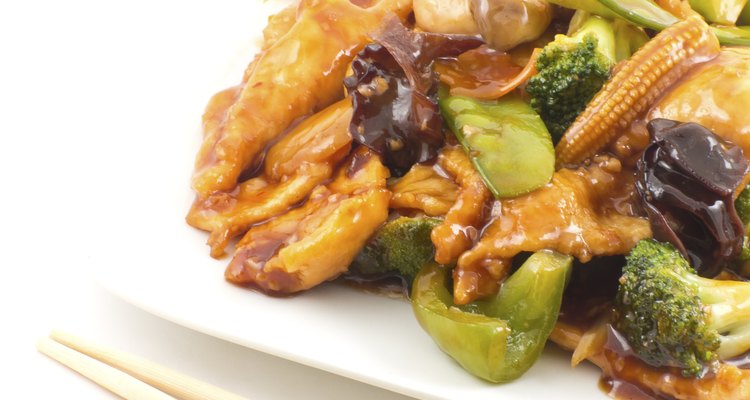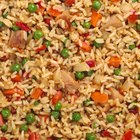
MackoFlower/iStock/Getty Images
According to Calorie Lab, the traditional Chinese dish known as Hunan chicken is sautéed chicken with green peppers and onions in a black bean sauce. While sautéed chicken tends to be healthier than fried chicken, Hunan chicken is still high in sodium and cholesterol, making it a dish best enjoyed only occasionally.
General Nutrition Data
A one-cup serving of Hunan chicken provides 385 calories, about 120 of which come from fat. The peppers and onions contain some carbohydrates, so one cup contains a total of 13 g of carbs, with 3 g of dietary fiber.
Protein and Fat
Due to the chicken and black beans in Hunan chicken, the dish is a good source of protein. One cup of Hunan chicken contains 51 g of protein, but it also contains a high level of fat and cholesterol. One cup contains 14 g of total fat, with 3 g of saturated fat, which is considered one of the unhealthiest fats. It also contains 135 mg of cholesterol in just one serving, almost half the recommended daily limit of 300 mg.
Sodium
One of the biggest negatives about Hunan chicken is its sodium content -- 1,040 mg in a one-cup serving. According to the American Heart Association, your daily limit should be under 1,500 mg of salt. A diet high in sodium can contribute to health problems, from high blood pressure to heart disease, and an increased risk of stroke. Because just one serving of Hunan chicken causes you almost to reach your daily recommended limit, it should not be a food you eat regularly.
Vitamins and Minerals
Hunan chicken does contribute a variety of essential vitamins and minerals. For example, according to the USDA Nutrient Database, the onions and green peppers are a good source of potassium, while the chicken is high in phosphorus and B vitamins. The dish is also a good source of choline and vitamin K, with traces of iron, zinc, copper, manganese and vitamin E.
Related Articles

How to Cook Chicken Cutlets Without ...

How to Par-Cook Chicken Before Frying

How to Cook Half a Breast of Chicken

How to Cook Chicken Thighs

How to Broil Chicken on the Bone

How to Make Crock-pot Chicken

How Many Calories Are in a Chicken ...

How to Cook Chicken Bratwurst

How to Bake Chicken Breast Without Oil

How Many Calories in a Taco Bell Bean ...

How to Get a Thick Coating on Fried ...

Baked BBQ Chicken Recipe
Easy Sweet and Sour Chicken Recipe

How to Defrost a Chicken in a ...

How to Cook Arroz Chaufa

How to Cook Mojo Chicken

How to Cook Sauteed Chicken With White ...

How to Cook Chicken Schnitzel

Can I Cook a Chicken Five Days After ...

Alternatives for Mayonnaise in Chicken ...
References
Writer Bio
Joseph McAllister has worked as a writer since 2003. He has more than seven years of experience in training and coaching martial arts. McAllister writes for various websites on a variety of topics including martial arts, competition and fitness. He graduated from Liberty University on a full ride National Merit Scholarship with a Bachelor of Science in print journalism.
Photo Credits
MackoFlower/iStock/Getty Images